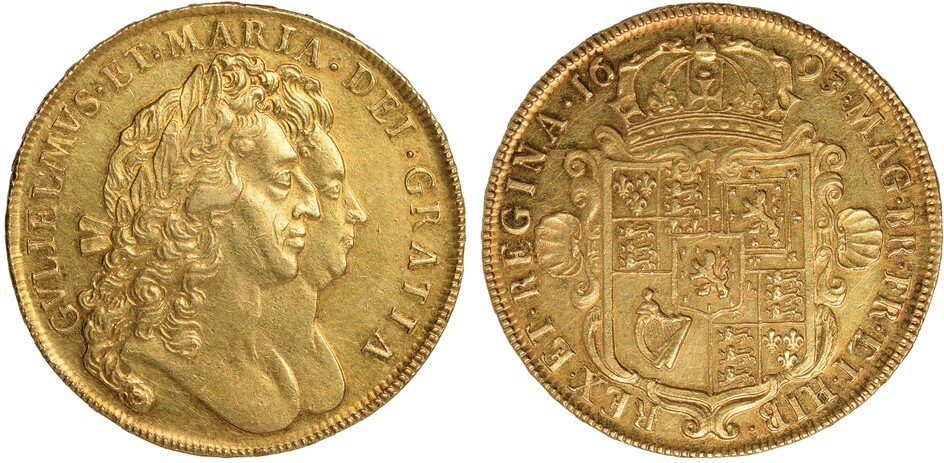The Gold Section, British Coins
William and Mary, five guineas, 1693, QVINTO, conjoined busts r., rev. crowned shield of arms (S.3422), certified and graded by NGC as About Uncirculated 58
Gold coins were not the currency used by ordinary subjects prior to the 18th century, when commerce flourished for the nation as a whole as the Industrial Revolution changed the course of history forever. At the end of the 17th century, when this coin was struck, its intended use was primarily at court, with the landed gentry, and by banks, just then becoming established as true institutions. The value represented by five guineas in gold was just staggering by most people’s estimation, equal to the earnings of months of labour for the common man. As a consequence, the Royal Mint gave most of its attention to making ‘small change’ as we might call it today: coppers and tin for Charles II and James II, and then a more regular production of both types of minor coins under William & Mary. The other focus of the Mint was silver, in the main from halfcrowns down. Gold coins were made in much more limited numbers, the metal itself being scarce, but in fact they offered the finest ‘advertising’ of the country’s wealth, both at home and abroad. For this purpose, the portraiture and a new style of reverse (with seashells beside a crowned royal shield, replacing the cruciform of the previous two reigns’ large gold) were provided for a pair of monarchs. The engraving was performed by James and Norbert Roettiers, whose father, John, was on the verge of retirement by the early 1690s. There was cause for this kind of special design: old James II’s abdication, for the sake of his Catholic vows, paved the way for new blood mixed with the old, Mary II being his eldest daughter, married to the Protestant William of Orange. New faces, a crisp and different royal badge on the reverse of their coins, and fate was sealed: the pair accepted the offer of the throne by signing a Declaration of Rights. This established the supremacy of Parliament and issued in a new era of politics dominating the old monarchical rights and privileges. And yet, no coin ever looked more royal than this splendidly designed, huge piece of golden money.
View it on
Sale price
Estimate
Time, Location
Auction House
William and Mary, five guineas, 1693, QVINTO, conjoined busts r., rev. crowned shield of arms (S.3422), certified and graded by NGC as About Uncirculated 58
Gold coins were not the currency used by ordinary subjects prior to the 18th century, when commerce flourished for the nation as a whole as the Industrial Revolution changed the course of history forever. At the end of the 17th century, when this coin was struck, its intended use was primarily at court, with the landed gentry, and by banks, just then becoming established as true institutions. The value represented by five guineas in gold was just staggering by most people’s estimation, equal to the earnings of months of labour for the common man. As a consequence, the Royal Mint gave most of its attention to making ‘small change’ as we might call it today: coppers and tin for Charles II and James II, and then a more regular production of both types of minor coins under William & Mary. The other focus of the Mint was silver, in the main from halfcrowns down. Gold coins were made in much more limited numbers, the metal itself being scarce, but in fact they offered the finest ‘advertising’ of the country’s wealth, both at home and abroad. For this purpose, the portraiture and a new style of reverse (with seashells beside a crowned royal shield, replacing the cruciform of the previous two reigns’ large gold) were provided for a pair of monarchs. The engraving was performed by James and Norbert Roettiers, whose father, John, was on the verge of retirement by the early 1690s. There was cause for this kind of special design: old James II’s abdication, for the sake of his Catholic vows, paved the way for new blood mixed with the old, Mary II being his eldest daughter, married to the Protestant William of Orange. New faces, a crisp and different royal badge on the reverse of their coins, and fate was sealed: the pair accepted the offer of the throne by signing a Declaration of Rights. This established the supremacy of Parliament and issued in a new era of politics dominating the old monarchical rights and privileges. And yet, no coin ever looked more royal than this splendidly designed, huge piece of golden money.



